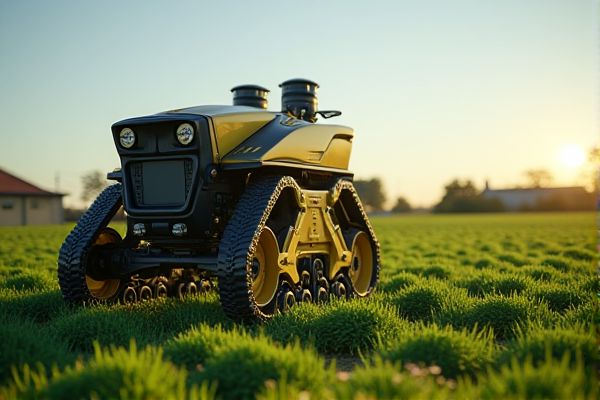
AI technology enhances agricultural robotics by improving efficiency and precision in farming operations. Autonomous robots equipped with AI can monitor crop health, identify pest infestations, and optimize irrigation processes, resulting in higher yields and reduced resource waste. Machine learning algorithms analyze vast amounts of data, enabling farmers to make informed decisions based on real-time insights. This innovation fosters sustainable farming practices, promoting environmental stewardship while ensuring food security.
AI usage in agricultural robotics
Crop Monitoring
AI in agricultural robotics enhances crop monitoring by analyzing data from sensors and drones. This technology can predict crop health, allowing farmers to optimize resource usage. For example, precision agriculture practices enable institutions like the University of California to effectively manage water and fertilizer. These advancements can lead to increased yields and reduced operational costs.
Precision Farming
AI plays a significant role in agricultural robotics and precision farming by optimizing crop management and increasing yield. Technologies such as autonomous drones can monitor crop health, offering farmers real-time data to make informed decisions. The integration of machine learning algorithms enables more efficient resource allocation, such as water and fertilizer. This advancement can lead to reduced costs and improved sustainability for institutions like agricultural research centers.
Automated Harvesting
AI in agricultural robotics, specifically in automated harvesting, can improve efficiency and reduce labor costs. For instance, systems like the Harvest CROO Robotics machine significantly increase the speed at which crops, such as strawberries, can be harvested. This technology allows farmers to respond more promptly to crop readiness, potentially minimizing waste. The integration of AI can also lead to better predictive analytics, helping farmers optimize yield profits.
Pest Control
AI can significantly enhance pest control in agricultural robotics by enabling precise monitoring and intervention. For example, systems equipped with AI algorithms can identify specific pest species and assess their population dynamics, leading to targeted application of pesticides. This increases the efficiency of treatments while minimizing chemical use, benefiting both crops and the environment. Institutions like the University of California are researching ways to integrate AI technology in these robotic systems to improve sustainability in agriculture.
Soil Analysis
AI applications in agricultural robotics enable precise soil analysis, potentially increasing crop yields and optimizing resource use. Technologies such as soil sensors paired with machine learning algorithms allow farmers to assess soil health more effectively. For instance, an institution like the University of California is researching AI-driven methods that provide real-time data, aiding agricultural decision-making. This integration can lead to tailored fertilizer applications, improving productivity and sustainability in farming practices.
Yield Prediction
AI-driven agricultural robotics can enhance yield prediction accuracy by analyzing historical and real-time data from various sources, such as weather patterns and soil conditions. Technologies like machine learning algorithms can process this data to identify trends and forecast crop performance. For instance, a smart farming solution from companies like John Deere employs AI to optimize resource allocation, potentially increasing overall yield. This integration presents a significant advantage by allowing farmers to make informed decisions based on precise predictions.
Irrigation Management
AI usage in agricultural robotics can enhance irrigation management by optimizing water usage and improving crop yields. Tools equipped with AI can analyze soil moisture levels and weather predictions to determine the most effective irrigation schedules. An example is the integration of AI with automated irrigation systems, which can lead to reduced water waste and increased efficiency. Implementing such technology in farms may present opportunities for increased productivity and sustainability in agriculture.
Livestock Monitoring
AI in agricultural robotics offers the potential to enhance livestock monitoring. Through the use of sensors and machine learning algorithms, farmers can gain insights into animal behavior and health, leading to more efficient herd management. For instance, companies like Trimble provide solutions that monitor livestock movements and vital signs. This technology could reduce operational costs and improve overall productivity on farms.
Drone Surveillance
AI in agricultural robotics enhances efficiency through precision farming techniques, allowing for targeted interventions that can increase crop yield. Drone surveillance provides real-time data collection, enabling farmers to monitor crop health and spot pest infestations early. Implementing these technologies can reduce resource waste, such as water and fertilizers, leading to cost savings. For instance, using AI-driven drones from companies like DJI can revolutionize traditional farming practices.
Farm Management Systems
AI has the potential to significantly enhance agricultural robotics and Farm Management Systems by optimizing crop yields and resource use. For instance, automated drones equipped with AI can monitor crop health and irrigation needs, allowing farmers to make data-driven decisions. The integration of AI can lead to more efficient planting, fertilization, and pest control, ultimately reducing operational costs. With the increasing demand for food production, leveraging such technologies could offer competitive advantages to modern farming operations.
 techknowy.com
techknowy.com